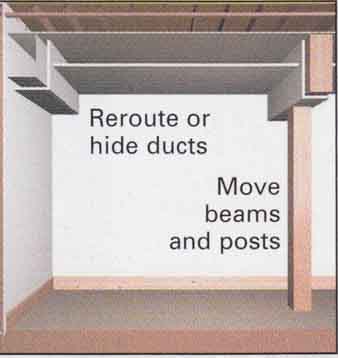Many basements are not suitable for home offices. Moisture, headroom, and access are often insurmountable problems. But when the conditions are right—or can be made right—a basement office is one of the easiest and least disruptive office conversions.
ASSESSING THE BASEMENT
Before you decide to convert a basement, check your local building code for regulations on basement remodels. Here are some of the common requirements you may have to meet:
Headroom for an office must be at least 7 feet, 3 inches, except under obstructions such as pipes and ducts, which can be as low as 6 feet, 6 inches. Don’t forget to factor the added height of the finished floor and ceiling.
Basement stairs must be up to code. You may need to rebuild and reconfigure the stairs and the railing. Simply adding a new floor will affect the height of the first step and that alone may necessitate a new stairway.
You may be required to provide an emergency exit, typically a window that measures at least 20x24 inches, located within 44 inches of the floor. If a garage adjoins the intended office space, a special fire-rated door may be required between the two spaces and the walls may have to be insulated.
Don’t give up, however, if you are unable to satisfy the code. Talk to your building inspector about your plans and how to apply for a code variance. If granted, a variance will allow you to proceed even if your plans are not completely up to code. Obtaining a variance may take a couple of months, You stand a better chance of receiving one if it’s not a safety issue.

To avoid the feeling of claustrophobia
in a basement, get as much headroom and as much natural light as possible.
DEALING WITH MOISTURE
Moisture should be your first concern. If the basement isn’t dry, or can’t be made dry, it makes little sense to consider bringing office equipment and valuable papers into the environment. Walls and floors must be sound and dry year-round. There should be no cracks larger than 1/4 inch and no water leakage.
If there are no obvious signs of standing water or other indications of high humidity, look for mildew or water stains under wood partitions, stair stringers, or floor coverings. If the walls or floor feel damp, even occasionally, tape 12-inch squares of heavy plastic at various locations below grade. Inspect the plastic every couple of days. If water is trapped on the back side, seepage is likely the problem. If water droplets form on the outside of the patch, condensation should be suspected. Remedies vary, depending on the type of problem.
Condensation often can be reduced by insulating cold water pipes, increasing ventilation, and directing bathroom and clothes dryer vents outdoors. Mild condensation problems can be controlled with a dehumidifier.
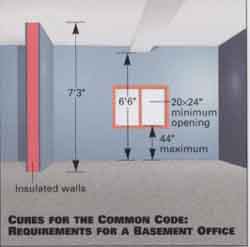
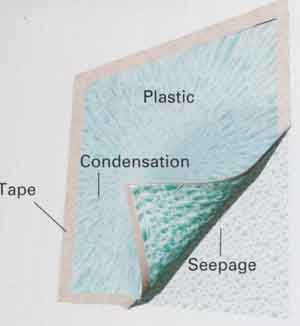
CHECKING FOR MOISTURE
The primary cause of seepage is water runoff from the roof. Gutters and downspouts are intended to collect that water and direct it away from the foundation. But when they become clogged, corroded, or disconnected, the water falls close to the house’s perimeter. Repair or replace any sections of gutters and downspouts that are leaking or disconnected. Clean leaves and other debris from the gutters every year. Gutters should slope gradually toward each downspout, and downspout extensions and splash blocks or leaders should be used to conduct the water away from the foundation.
Other causes of seepage include poor grading, leaking window wells, and damage to the house siding. Tree roots near the foundation often cause serious damage, leading to water leaks, If fixing these problems does not result in a dry basement, the foundation may need a perimeter drain. This is a job for a professional.
If your basement becomes wet at particular times of the year, it may be that the water table is too high. There are no reasonable cures for such a condition, although a properly installed sump pump could mitigate the problem substantially. It would be wise to consult a specialist before trying to construct a home office in a space that could face periodic flooding.
Basements without serious water problems can be given added protection with a crystalline waterproofing material, which is sold at home centers and lumberyards. These products are a blend of cement, sand, and chemical catalysts that you blend with water and apply with a brush. The catalyst penetrates the concrete, where it plugs holes and holds water at bay.

REPAIRING CRACKS
If you find water leaking through a crack in the basement wall, chisel out the crack to a depth of about ¼ inch. Run a bead of silicone caulk along the crack. After it has had a chance to cure, fill the groove with quick-setting hydrostatic cement available at home centers and lumberyards. Push the cement in tightly with a trowel. (Note that if the wall is concrete block, you should only chisel along mortar joints. Fill cracks in the blocks themselves without chiseling.)
REMODELING
Unlike attics and garages, basements need not be finished with new walls. If you like the industrial look, you can simply paint with special masonry paint designed to adhere to concrete and brick. Apply it with a roller.
If you are not going to install a dropped ceiling, paint the area overhead white or a light color; bare joists can give your office a gloomy, closed-in feeling. Rent a paint sprayer and use latex paint the same color as the masonry paint used on the walls. Two coats probably will be necessary because dry wood absorbs paint. When painting, ventilate by opening all windows and using a floor fan.
If you prefer finished, insulated outside walls, give 1½-inch rigid foam to the walls between panels with construction adhesive. Seal the joints with foil tape. Then frame standard 2x4 walls, with studs 16 inches on center. This provides plenty of room in the wall for wiring and plumbing. You can finish the wall with wallboard.
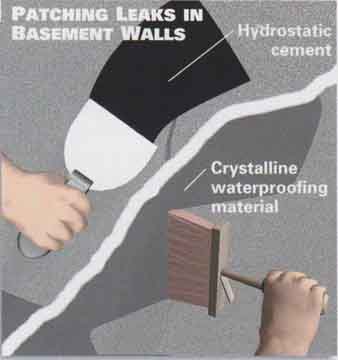
Install a floor only after all moisture problems have been solved. Cover the floor with 6-mil polyethylene sheeting, overlapping seams at least 6 inches. Run the sheeting up the wall—it can be trimmed flush with the finished floor later.
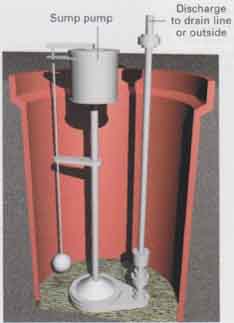
Sump pump; Discharge to drain line or outside.
Lay down pressure-treated 1x3 sleepers, wide face down, 16 inches on center. Fasten the sleepers with masonry screws or a powder-actuated gun. Set panels of extruded foam insulation on the floor between the sleepers. Attach 3 tongue-and-groove plywood to the sleepers with construction adhesive on the sleepers and in the joint and 1½-inch screws or ring-shank nails. Leave a ½-inch gap between the floor and the walls, Install the finish floor surface of your choice.
Alternatively, install ¾-inch wood strip flooring instead of the plywood.
Outlets in the basement will need to be protected by ground fault circuit interrupters (GFCI), required by most electrical codes. This can be done either by wiring the first outlet in a series of outlets on the circuit with a GFCI outlet, or by installing a GFCI breaker in the panel to protect the entire circuit.
You usually can heat the basement by extending whatever heating system is used in the house. If that's impractical, add a 20-amp circuit and install an electric baseboard heater, Although cooling a basement isn’t usually necessary, it’s good to have some means of circulating air. Window-mounted fans exhaust stale air and draw in fresh air through another open window.
If the basement is completely unfinished, construct a partition wall to separate the heating unit from the work area. You may be able to enclose the heating unit in a closet, but be aware that local codes are very strict on the ventilation around a heating unit and fire retardant rating of wallboard and doors. The door may have to be fire rated, so check with authorities before you begin construction.
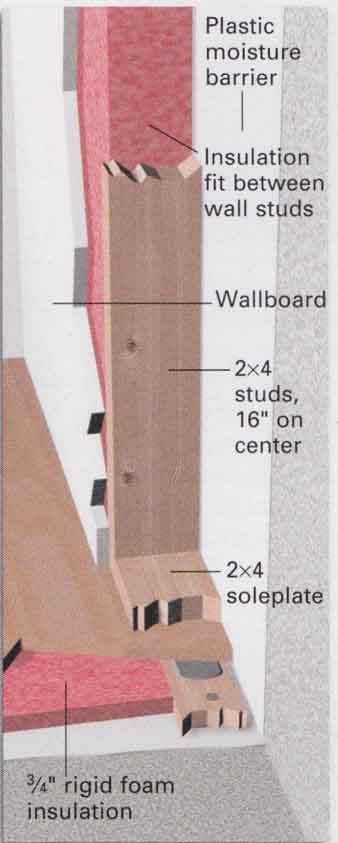
AN INSULATED BASEMENT WALL: Plastic moisture
barrier; Insulation fit between wall studs; Wallboard; 2x4 studs, 16”
on center; 2x4 soleplate; 3/4 rigid foam insulation.
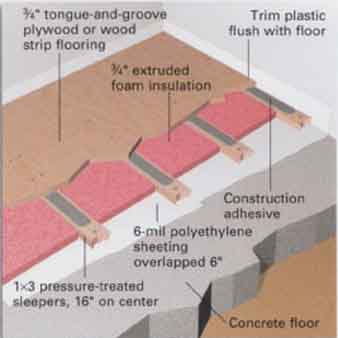
A worker needs an occasional change of
scene from a computer screen. When windows aren’t available, as in a
basement office, you can satisfy your craving for a view with photographs,
collectibles, and similar objects to ponder while thinking those deep
thoughts.
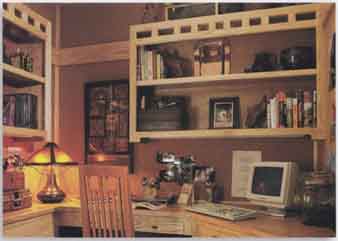
INSTALLING A BASEMENT FLOOR
ADDING A CEILING IN A BASEMENT
There are various ways to install a basement ceiling, depending on headroom and obstructions, If headroom is sufficient, a continuous suspended ceiling can be installed. A suspended ceiling has the advantages of leaving utility lines accessible, hiding sagging or uneven joists, simplifying the installation of light fixtures, and muffling sound. These ceilings come in many colors and styles, and instructions for installation are usually included.
Be sure that areas concealed by the new ceiling are insulated wherever necessary, especially in the rim joist area. Insulate any cold-water pipes to prevent condensation and dripping.
To install a suspended ceiling, mark level lines around the walls of the room at the height of the finished ceiling, which should be at least 7 feet, 3 inches above the finished floor. Use a long level or measure up from the floors, provided they are level.
Nail a metal molding strip around the perimeter of the basement, using the level marks as guides. Suspend main runners from the floor joists with screw eyes and wire. Space them 4 feet apart.
Fit cross tees between the runners to complete the grid. Use the slots in the runners for proper spacing. Slip the ceiling tiles and lighting panels into the framework. The tiles usually measure 2 feet by 4 feet and are held in place by their own weight.
RE-ROUTING OBSTRUCTIONS: Basement ceilings are often cluttered with pipes and ductwork that are unsightly and in the way. If the problem is merely cosmetic, you can mask the eyesore by covering it with a more attractive material. Ductwork often can be moved from the center of the basement to the perimeter without much effort. You probably should have a heating and cooling contractor handle this type of work, since re-routing ducts can affect the performance of the system. Posts and beams are other likely candidates for relocation, but because of their structural importance, consult a professional first.
The most difficult obstacles to relocate are often the drain lines. Because they depend on gravity to function, drain lines must maintain a continuous slope with a minimum of turns. Sometimes, drain lines can be moved to run under the floor, but this is work that should be done by a competent contractor.
Usually the toughest part of adding a basement bathroom is running the drain lines. It is easiest to add a bathroom in the basement if the main drain line already runs under the basement floor. That way, you will be able to tie the new sink and toilet drains into the main line by using a hubless fitting. To locate the main drain line, note where all the drains from above enter the floor, then find where the drain exits the house (usually on the street side). With this information, you should be able to track the path of the main drain. Use chalk or paint to draw the line on the concrete slab. Break through the concrete with a sledgehammer or rented electric jackhammer. If the main drain line is above the floor, talk to a plumber about installing a sewage ejector. |
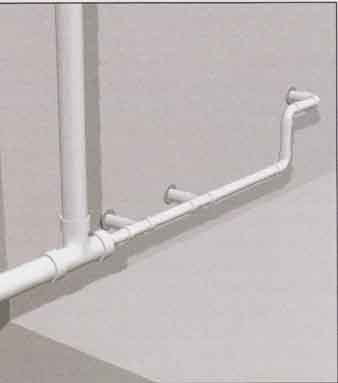
RELOCATING DRAIN LINES: Exposed drain lines
in the basement can be difficult to hide. Cabinets can conceal the pipes and add storage. The pipes remain accessible for plumbing work.
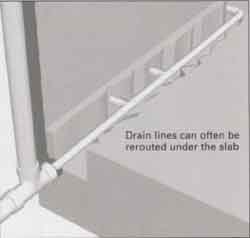
A more complex fix for this problem entails
cutting channels in the slab to contain new drainpipes.
Drain lines can often be rerouted under the slab.
